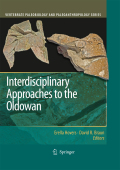
An understanding of the uniquely human behavior of stone tool making tackles questions about hominins’ ability to culturally transmit and expand their baseof social and practical knowledge and their cognitive capacities for advancedplanning. The appearance of stone tools has often been viewed as a threshold event, impacting directly and profoundly the later course of cultural and social evolution. Alternatively, it has been understood as a prelude to significant succeeding changes in behavioral, social and biological evolution of hominins. This book presents a series of recent enquiries into the technological and adaptive significance of Oldowan stone tools. While anchored in a long research tradition, these studies rely on recent discoveries and innovative analyses of the archaeological record of ca. 2.6–1.0 million years ago in Africa and Eurasia, dealing with the earliest lithic industries as manifestations of hominin adaptations and as expressions of hominin cognitive abilities. Provides a unique perspective on early stone tool manufacture and use Describes the earliest known assemblages and their significance in understanding processes of cultural evolution and change INDICE: From the contents 1. Introduction: Current issues in Oldowan research. 2. Remarks on the current theoretical and methodological approaches to the study of technological strategies of early humans in Eastern Africa. 3. Fromhomogeneity to multiplicity: A new approach to the study of archaic stone tools. 4. An overview of some African and Eurasian Oldowan sites: Evaluation of hominin cognitive levels, technological advancement and adaptive skills. 5. Early Homo occupation near the ‘Gate of Tears’: Examining the paleoanthropological records of Djibouti and Yemen. 6. Homo floresiensis and the African Oldowan.7. Methodological issues in the study of Oldowan raw material selectivity: Insights from A. L. 894 (Hadar, Ethiopia). 8. Variability in raw material selectivity at the late Pliocene sites of Lokalalei, West Turkana, Kenya. 9. Oldowantechnology and raw material variability at Kanjera South.
- ISBN: 978-1-4020-9059-2
- Editorial: Springer
- Encuadernacion: Cartoné
- Páginas: 190
- Fecha Publicación: 01/11/2008
- Nº Volúmenes: 1
- Idioma: Inglés
